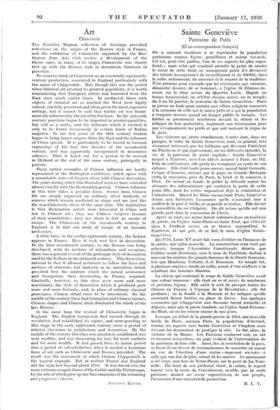Art
Chinoiserie TuE Fauchier - Magnan collection of drawings prevoked reflections on the origins of the Rococo style in France, and the exhibition of Chinoiserie organised by the Bur- lington Fine Arts Club invites a development of the theme since, in many of its stages, Chinoiserie was closely tied up with the Rococo style in decoration, furniture or porcelain.
We tend to think of Chinoiserie as an essentially eighteenth- century production, associated in England particularly with the name of Chippendale. But, though this was the period when Oriental art attained its greatest popularity, it is worth remembering that European artists had borrowed from the East since much earlier times. In mediaeval times such objects of Oriental art as reached the West were highly valued, carefully preserved and often given the most expensive settings, but it cannot be said that Gothic art was funda- mentally influenced by the art of the Far East. In the sixteenth century porcelain began to be imported in greater quantities, but still as a rarity, and the influence which it exerted is only to be found occasionally in certain kinds of Italian majolica. In the last years of the 16th century traders began to bring larger cargoes from the East and the influence of China spread. It is particularly to be traced in German engravings of the first two decades of the seventeenth century and was apparently incorporated in decorative schemes. Then it faded out for a period, to be .revived in Holland at the end of the same century, principally in pottery.
These earlier examples of Chinese influence are hardly represented at the Burlington exhibition, which opens with a remarkable series of English silver with Chinese decoration.
The years during which this flourished seem to have coincided almost exactly with the Restoration period. Chinese influence at this time takes a peculiar form. Scenes from Chinese life are simply engraved on ordinary silver tankards or sconces which remain unaltered in shape and are just like the non-Chinoiserie silver of the same date. The implication is that Restoration artists were interested in China and not in Chinese art ; they use Chinese subjects because
of their associations ; they use them in fact as means of escape. The Chinoiserie of the seventeenth century in England is in fact one mode of escape of an insecure aristocracy.
A little later, in the earlier eighteenth century, the fashion appears in France. Here it took root first in decoration.
In the later seventeenth century, as the Rococo was being developed, with its mixture of rationalism and escapism, there was a general revival of the grotesque style of decoration used by the Italians in the sixteenth century. This decoration, rational in that it allowed architects to follow the lines and surfaces of structure, but fantastic in its unrealistic detail, provided first the mixture which the mixed aristocracy and bourgeoisie, then dominating in France, required.
Gradually, however, as • this class grew more and more reactionary, the style of decoration which it produced grew more and more fantastic, and, in place of ordinary classical grotesques, Chinese detail came to be introduced. By the middle of the century these had triumphed and Chinese themes, Chinese shapes and Chinese dress dominated the whole of the late Rococo.
At the same time the revival of Chinoiserie began in England. The English bourgeoisie had carried through its
revolution, had established its regime, and corresponding to
this stage in the early eighteenth century came a period of relative classicism in architecture and decoration. By the middle of the century this class was absolutely established, was very wealthy, and was clamouring for war, for more markets and for more wealth. It had passed from its heroic period
into a period of self-satisfaction when it needed a luxurious form of art such as Chinoiserie and Rococo provided. The result was the movement of which Chinese Chippendale is the typical example. But in neither France nor England did the style last beyond about 1770. It was forced into the more extreme escapist forms of the Gothic and the Picturesque, by the side of which grew up the Neo-classicism of the reforming and progressive classes.
ANTITONY BLUNT.






































 Previous page
Previous page